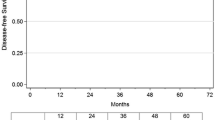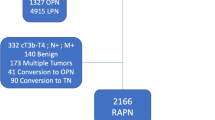Abstract
Background
To evaluate long-term oncological and renal function outcomes in patients treated with robot-assisted partial nephrectomy (RAPN) for renal cell carcinoma (RCC).
Patients and Methods
Patients undergoing RAPN for clinically localized RCC between January 2014 and December 2019 at a tertiary robotic reference center were evaluated. Clinical course, pathologic characteristics, and long-term outcomes were obtained from our institutional review board-approved RCC database.
Results
A total of 234 patients were available for analysis. Median follow-up was 46 months (10.8–97.8 months), with 77 patients (32.9%) having at least 5-years of follow-up. Pathology revealed clear-cell RCC in 67.5% (n = 158). Among unfavorable factors, nuclear grades 3 or 4 were found in 67 (29.4%), lymphovascular invasion in 10 (4.3%), positive surgical margins in 22 (9.4%), necrosis in 21 (9%), and sarcomatoid pattern in 2 patients (0.9%). At 12 months, mean serum creatinine was 1.04 mg/dL and 12.9% of patients experienced upstaging in chronic kidney disease. Overall recurrence-free survival at 5-years was 97.8%. There were five local (2.1%) and two distant (0.9%) recurrences, none of them resulting in cancer-specific death. Median time to recurrence was 20 months (11–64 months). Warm ischemia time [hazard ratio (HR) = 1.14, p = 0.034] and sarcomatoid pattern (HR = 124.57, p = 0.001) were the only variables associated with local relapse.
Conclusions
Data from this large cohort demonstrate that patients undergoing RAPN have a low incidence of local and distant relapse, resulting in excellent long-term survival while preserving stable renal function in most patients.


Similar content being viewed by others
References
Ljungberg B, Albiges L, Bensalah K, et al. EAU guidelines on renal cell carcinoma. Eur Urol. Published online 2020. http://uroweb.org/guidelines/compilations-of-all-guidelines/
Porpiglia F, Mari A, Bertolo R, et al. Partial Nephrectomy in clinical T1b renal tumors: multicenter comparative study of open, laparoscopic and robot-assisted approach (the RECORd Project). Urology. 2016;89:45–51. https://doi.org/10.1016/j.urology.2015.08.049.
Bertolo R, Garisto J, Dagenais J, et al. Transperitoneal robot-assisted partial nephrectomy with minimum follow-up of 5 years: oncological and functional outcomes from a single institution. Eur Urol Oncol. 2019;2(2):207–13. https://doi.org/10.1016/j.euo.2018.06.012.
Hung AJ, Cai J, Simmons MN, Gill IS. “Trifecta” in partial nephrectomy. J Urol. 2013;189(1):36–42. https://doi.org/10.1016/j.juro.2012.09.042.
Kutikov A, Uzzo RG. The RENAL nephrometry score: a comprehensive standardized system for quantitating renal tumor size, location and depth. J Urol. 2009;182(3):844–53. https://doi.org/10.1016/j.juro.2009.05.035.
Dindo D, Demartines N, Clavien P-A. Classification of surgical complications: a new proposal with evaluation in a cohort of 6336 patients and results of a survey. Ann Surg. 2004;240(2):205–13. https://doi.org/10.1097/01.sla.0000133083.54934.ae.
Edge S, Byrd DR, Compton CC, Fritz AG, Greene F, Trotti A, eds. AJCC Cancer Staging Handbook: From the AJCC Cancer Staging Manual. 7th ed. Springer; 2010. Accessed April 9, 2021. https://www.springer.com/gp/book/9780387884424
Lopez-Beltran A, Scarpelli M, Montironi R, Kirkali Z. 2004 WHO classification of the renal tumors of the adults. Eur Urol. 2006;49(5):798–805. https://doi.org/10.1016/j.eururo.2005.11.035.
Cornejo KM, Rice-Stitt T, Wu C-L. Updates in staging and reporting of genitourinary malignancies. Arch Pathol Lab Med. 2020;144(3):305–19. https://doi.org/10.5858/arpa.2019-0544-RA.
Levey AS, Coresh J, Balk E, et al. National Kidney Foundation practice guidelines for chronic kidney disease: evaluation, classification, and stratification. Ann Intern Med. 2003;139(2):137–47. https://doi.org/10.7326/0003-4819-139-2-200307150-00013.
Kim DK, Kim LHC, Raheem AA, et al. Comparison of trifecta and pentafecta outcomes between T1a and T1b renal masses following robot-assisted partial nephrectomy (RAPN) with minimum one year follow up: can RAPN for T1b renal masses be feasible? PLoS ONE. 2016. https://doi.org/10.1371/journal.pone.0151738.
Rassweiler J, Goezen AS. Laparoscopic partial nephrectomy in the era of robotic surgery: there is a role! Minerva Urol E Nefrol Ital J Urol Nephrol. 2018;70(1):6–8. https://doi.org/10.23736/S0393-2249.17.03039-9.
Mari A, Antonelli A, Bertolo R, et al. Predictive factors of overall and major postoperative complications after partial nephrectomy: results from a multicenter prospective study (The RECORd 1 project). Eur J Surg Oncol. 2017;43(4):823–30. https://doi.org/10.1016/j.ejso.2016.10.016.
Ghani KR, Sukumar S, Sammon JD, Rogers CG, Trinh Q-D, Menon M. Practice patterns and outcomes of open and minimally invasive partial nephrectomy since the introduction of robotic partial nephrectomy: results from the nationwide inpatient sample. J Urol. 2014;191(4):907–12. https://doi.org/10.1016/j.juro.2013.10.099.
Simhan J, Smaldone MC, Tsai KJ, et al. Perioperative outcomes of robotic and open partial nephrectomy for moderately and highly complex renal lesions. J Urol. 2012;187(6):2000–4. https://doi.org/10.1016/j.juro.2012.01.064.
Kyllo RL, Tanagho YS, Kaouk JH, et al. Prospective multi-center study of oncologic outcomes of robot-assisted partial nephrectomy for pT1 renal cell carcinoma. BMC Urol. 2012;12:11. https://doi.org/10.1186/1471-2490-12-11.
Vartolomei MD, Matei DV, Renne G, et al. Robot-assisted partial nephrectomy: 5-yr oncological outcomes at a single European tertiary cancer center. Eur Urol Focus. 2019;5(4):636–41. https://doi.org/10.1016/j.euf.2017.10.005.
Andrade HS, Zargar H, Caputo PA, et al. Five-year oncologic outcomes after transperitoneal robotic partial nephrectomy for renal cell carcinoma. Eur Urol. 2016;69(6):1149–54. https://doi.org/10.1016/j.eururo.2015.12.004.
Sun M, Shariat SF, Cheng C, et al. Prognostic factors and predictive models in renal cell carcinoma: a contemporary review. Eur Urol. 2011;60(4):644–61. https://doi.org/10.1016/j.eururo.2011.06.041.
Zhang L, Zha Z, Qu W, et al. Tumor necrosis as a prognostic variable for the clinical outcome in patients with renal cell carcinoma: a systematic review and meta-analysis. BMC Cancer. 2018;18(1):870. https://doi.org/10.1186/s12885-018-4773-z.
Lane BR, Demirjian S, Derweesh IH, et al. Survival and functional stability in chronic kidney disease due to surgical removal of nephrons: importance of the new baseline glomerular filtration rate. Eur Urol. 2015;68(6):996–1003. https://doi.org/10.1016/j.eururo.2015.04.043.
Deng H, Fan Y, Yuan F, et al. Partial nephrectomy provides equivalent oncologic outcomes and better renal function preservation than radical nephrectomy for pathological T3a renal cell carcinoma: a meta-analysis. Int Braz J Urol. 2021;47(1):46–60. https://doi.org/10.1590/S1677-5538.IBJU.2020.0167.
Rothberg MB, Paulucci DJ, Okhawere KE, et al. A multi-institutional analysis of the effect of positive surgical margins following robot-assisted partial nephrectomy on oncologic outcomes. J Endourol. 2020;34(3):304–11. https://doi.org/10.1089/end.2019.0506.
Wood EL, Adibi M, Qiao W, et al. Local tumor bed recurrence following partial nephrectomy in patients with small renal masses. J Urol. 2018;199(2):393–400. https://doi.org/10.1016/j.juro.2017.09.072.
Bensalah K, Pantuck AJ, Rioux-Leclercq N, et al. Positive surgical margin appears to have negligible impact on survival of renal cell carcinomas treated by nephron-sparing surgery. Eur Urol. 2010;57(3):466–71. https://doi.org/10.1016/j.eururo.2009.03.048.
Tabayoyong W, Abouassaly R, Kiechle JE, et al. Variation in surgical margin status by surgical approach among patients undergoing partial nephrectomy for small renal masses. J Urol. 2015;194(6):1548–53. https://doi.org/10.1016/j.juro.2015.06.076.
Rothberg MB, Peak TC, Reynolds CR, Hemal AK. Long-term oncologic outcomes of positive surgical margins following robot-assisted partial nephrectomy. Transl Androl Urol. 2020;9(2):879–86. https://doi.org/10.21037/tau.2019.11.21.
Kang HW, Lee SK, Kim WT, et al. Surgical margin does not influence recurrence rate in pT1 clear cell renal cell carcinoma after partial nephrectomy: a multicenter study. J Surg Oncol. 2016;114(1):70–4. https://doi.org/10.1002/jso.24259.
Antic T, Taxy JB. Partial nephrectomy for renal tumors: lack of correlation between margin status and local recurrence. Am J Clin Pathol. 2015;143(5):645–51. https://doi.org/10.1309/AJCP7LKLZ8JSJQRG.
Kang M, Gong I-H, Park HJ, et al. Predictive factors for achieving superior pentafecta outcomes following robot-assisted partial nephrectomy in patients with localized renal cell carcinoma. J Endourol. 2017;31(12):1231–6. https://doi.org/10.1089/end.2017.0369.
Funding
None.
Author information
Authors and Affiliations
Contributions
Study concept and design: HO-A and MIF. Acquisition of data: HO-A, AK, and MIF. Analysis and interpretation of data: HO-A, AL, MIF, AK, and MS. Drafting of the manuscript: HO-A, AK, and MIF. Critical revision of the manuscript for important intellectual content: HO-A, MIF, AK, MO, CS, HB, AB, RL, and MS. Statistical analysis: HO-A. Obtaining funding: None. Administrative, technical, or material support: MIF and AB. Supervision: None.
Corresponding author
Ethics declarations
Disclosures
The authors have nothing to disclose.
Additional information
Publisher's Note
Springer Nature remains neutral with regard to jurisdictional claims in published maps and institutional affiliations.
Supplementary Information
Below is the link to the electronic supplementary material.
Rights and permissions
About this article
Cite this article
Otaola-Arca, H., Krebs, A., Bermúdez, H. et al. Long-Term Oncological and Functional Outcomes After Robot-Assisted Partial Nephrectomy for Clinically Localized Renal Cell Carcinoma. Ann Surg Oncol 29, 2484–2494 (2022). https://doi.org/10.1245/s10434-021-11133-4
Received:
Accepted:
Published:
Issue Date:
DOI: https://doi.org/10.1245/s10434-021-11133-4




